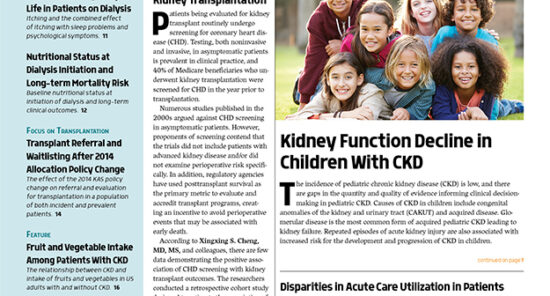Credit: Original article published here.Management of patients with anemia of chronic kidney disease (CKD) seeks to reduce red blood cell transfusions and avoid complications such as allosensitization. Researchers, led by Vivekanand Jha, MBBS, MD, DM, PhD, conducted an analysis of data on red blood cell transfusion needs in patients with CKD on and not on dialysis in the ASCEND-D and ASCEND-ND trials. Trial participants were treated with daprodustat, a novel hypoxia inducible factor prolyl hydroxylase inhibitor, or with erythropoiesis-stimulating agents (ESAs). Results were reported during a poster session at the National Kidney Foundation Spring Clinical Meetings 2023. The poster was titled The Effects of Daprodustat on Blood Transfusion Rates in the ASCEND-D and -ND Trials. The analysis included data on rates of red blood cell transfusions (events per 100 patient-years) in the ASCEND-D and ASCEND-ND trials and in the ASCEND-D ESA hyporesponder (ESA-HR) subgroup (baseline ESA-resistance index >2.0/>450 U/kg epoetin per week). In prespecified analyses, adjustments in Cox proportional model-estimated hazard ratios (HR) included treatment/region, dialysis type in ASCEND-D participants, and randomization-ESA use in ASCEND-ND trial participants. In both trials, red blood cell transfusions (≥5%) and overall red blood cell transfusion rates were numerically lower in patients in the daprodustat
Credit: Original article published here.According to Jake Hunnicutt, PhD, and colleagues, there are few data on the use of red blood cell transfusion among patients with anemia and nondialysis dependent chronic kidney disease (CKD) in the United States. Data on how the rates of red blood cell transfusion vary by hemoglobin level are also limited. During a poster session at the National Kidney Foundation Spring Clinical Meetings 2023, the researchers presented data on the rate of red blood cell transfusions and associated complications from 2017 to 2019. The poster was titled Red Blood Cell (RBC) Transfusion Use Varies by Baseline Hemoglobin (Hb) and Is Associated With Posttransfusion Hyperkalemia and Hospitalization Within 30 Days in US Patients With Stage 3-5 CKD and Anemia. The retrospective cohort study utilized Optum’s deidentified Integrated Claims-Clinical dataset. Inclusion criteria were hemoglobin measure (index date), prior evidence of stage 3-5 CKD, and anemia (defined as treatment for anemia or baseline hemoglobin <12 g/dL for women or <13 g/dL for men). Analyses were stratified by insurance type (commercial or Medicare Advantage [MA]). Associations between baseline hemoglobin and red blood cell transfusion events within 6 months were quantified using estimated adjusted rate ratios (aRR) and 95% CIs. Claims
Credit: Original article published here.Chronic kidney disease (CKD) affects approximately 13% of the population of the United States. Many patients adhere to preventive dietary patterns; however, according to Shirin Pourafshar, PhD, MSCR, RDN, and colleagues, empiric evidence to guide use of such measures is limited. Current dietary guidelines for patients with CKD focus on recommended nutrient intakes (sodium, potassium, and phosphorous) rather than on whole foods such as fruits and vegetables. Patients with CKD at risk for hyperkalemia limit intake of fruits and vegetables to avoid excess dietary potassium intake. Patients with mild-to-moderate CKD do not face a high risk of hyperkalemia, and restriction of dietary potassium may lower consumption of healthy foods such as fruits and vegetables. The 2000 update to the Clinical Practice Guideline for Nutrition in CKD from the National Kidney Foundation and the Academy of Nutrition and Dietetics includes the need for further evidence on food patterns and intake of fruits and vegetables in patients with CKD. Dr. Pourafshar et al conducted a study to examine the relationship between CKD and intake of fruits and vegetables in US adults with and without CKD. Results were reported in the Journal of Renal Nutrition [2023;33(1):88-96]. The researchers characterized
Credit: Original article published here.The incidence of pediatric chronic kidney disease (CKD) is low, and there are gaps in the quantity and quality of evidence informing clinical decision-making in pediatric CKD. Causes of CKD in children include congenital anomalies of the kidney and urinary tract (CAKUT) and acquired disease. Glomerular disease is the most common form of acquired pediatric CKD leading to kidney failure. Repeated episodes of acute kidney injury are also associated with increased risk for the development and progression of CKD in children. The most comprehensive data on the progression of CKD in children are from the Chronic Kidney Disease in Children (CKiD) study, an ongoing prospective cohort study that has enrolled more than 1000 children over three recruitment waves. According to Caroline A. Gluck, MD, and colleagues, CKiD data are limited by the relatively small sample size. The researchers conducted a study utilizing electronic heath record (EHR) data from a national multicenter pediatric network in the United States to identify a large cohort of children with CKD. The retrospective cohort study was designed to evaluate progression of CKD in the pediatric population and examine clinical risk factors for decline in kidney function. Results of the study were
Credit: Original article published here.Recent estimates suggest that 37 million adults in the United States, one in seven, have chronic kidney disease (CKD), excluding those with end-stage renal disease. As the population in the United States ages and as the prevalence of risk factors for CKD such as hypertension and obesity increase among all age groups, CKD is expected to become even more common. CKD is most prevalent among US adults ≥65 years of age; most of the research on the economic burden of CKD has focused on the Medicare population. Excluding patients with ESRD, costs from patients with CKD accounted for more than 22% ($81 billion) of the Medicare fee-for-service spending in 2018. Increasing CKD stage as well as common comorbidities such as heart failure and type 2 diabetes mellitus (T2DM) contribute to cost of care for this patient population. There are fewer data available on the burden of CKD for commercial payers. Results of some studies have suggested that an increase in all-cause costs due to increasing CKD sages among patients <65 years of age is similar to the observed increases among those ≥65 years of age. However, according to Haechung Chung, MPH, and colleagues, there is a






